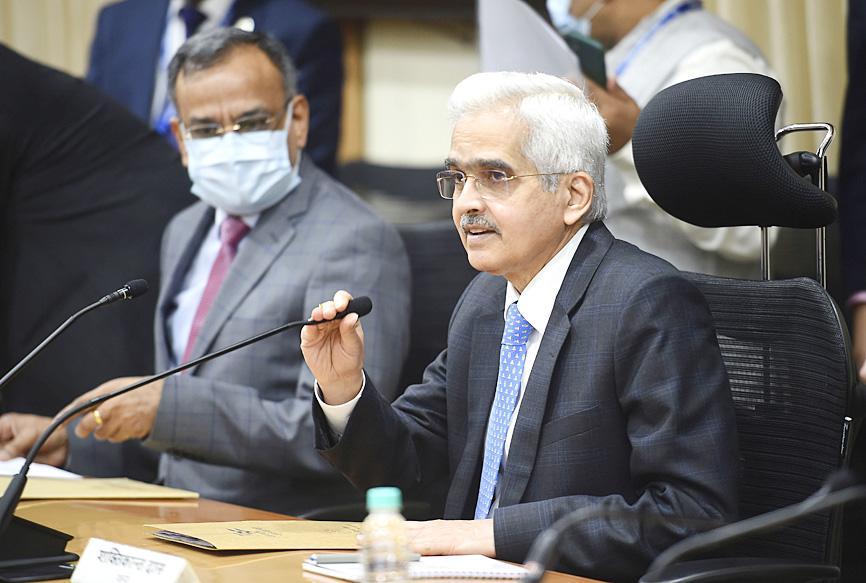The Reserve Bank of India yesterday hiked interest rates for the third time in four months as Asia’s third-largest economy contends with a widening trade deficit and weakening currency.
The central bank raised its key lending rate by 50 basis points to 5.40 percent — a level previously seen in August 2019 — three months after beginning a monetary tightening cycle in May.
“Successive shocks to the global economy are taking their toll,” Reserve Bank of India Governor Shaktikanta Das said in a televised address, pointing to surging inflation and lower global growth.

Photo: AP
“Disquietingly, globalization of inflation is coinciding with deglobalization of trade,” Das said. “The pandemic and the [Russia-Ukraine] war have ignited tendencies towards greater fragmentation.”
India bounced back strongly from the pandemic with one of the world’s fastest growth rates, but is now grappling with rising costs as commodity prices remain elevated.
The IMF last week slashed India’s growth outlook for the ongoing financial year ending March next year to 7.4 percent from the 8.2 percent it forecast in April.
A broad dollar rally in the past few months has contributed to the Indian rupee depreciating sharply to below 80, its lowest level against the greenback on record.
Das said the rupee has fared “much better” than other emerging-market currencies and “moved in a relatively orderly fashion, depreciating 4.7 percent against the US dollar” since April 1.
The Indian economy was “holding steady and progressing in an ocean of turbulence and uncertainty,” he said.
India’s merchandise trade deficit last month widened to a record US$31 billion, compared with US$10.6 billion in the same month last year, provisional data released on Tuesday showed.
Imports were more than twice as high as exports, led by petroleum products and coal.
India imports more than 80 percent of its crude oil needs and the country’s 1.4 billion people have been hit with rising gasoline costs.
Consumer inflation has consistently overshot the central bank’s 2 to 6 percent target range in the first six months of the year, hitting an eight-year high of 7.79 percent in April, before cooling to 7.01 percent in June.
The central bank retained its growth forecast at 7.2 percent for the 2022-2023 financial year and retained its inflation forecast at 6.7 percent.
Aggressive rate hikes by the US Federal Reserve have exacerbated outflows, with foreign investors withdrawing a net US$30 billion from debt and equity in the first half of this year.
India’s benchmark SENSEX erased early losses to trade 0.56 percent higher yesterday following the interest rate decision.

The US dollar was trading at NT$29.7 at 10am today on the Taipei Foreign Exchange, as the New Taiwan dollar gained NT$1.364 from the previous close last week. The NT dollar continued to rise today, after surging 3.07 percent on Friday. After opening at NT$30.91, the NT dollar gained more than NT$1 in just 15 minutes, briefly passing the NT$30 mark. Before the US Department of the Treasury's semi-annual currency report came out, expectations that the NT dollar would keep rising were already building. The NT dollar on Friday closed at NT$31.064, up by NT$0.953 — a 3.07 percent single-day gain. Today,

‘SHORT TERM’: The local currency would likely remain strong in the near term, driven by anticipated US trade pressure, capital inflows and expectations of a US Fed rate cut The US dollar is expected to fall below NT$30 in the near term, as traders anticipate increased pressure from Washington for Taiwan to allow the New Taiwan dollar to appreciate, Cathay United Bank (國泰世華銀行) chief economist Lin Chi-chao (林啟超) said. Following a sharp drop in the greenback against the NT dollar on Friday, Lin told the Central News Agency that the local currency is likely to remain strong in the short term, driven in part by market psychology surrounding anticipated US policy pressure. On Friday, the US dollar fell NT$0.953, or 3.07 percent, closing at NT$31.064 — its lowest level since Jan.

Hong Kong authorities ramped up sales of the local dollar as the greenback’s slide threatened the foreign-exchange peg. The Hong Kong Monetary Authority (HKMA) sold a record HK$60.5 billion (US$7.8 billion) of the city’s currency, according to an alert sent on its Bloomberg page yesterday in Asia, after it tested the upper end of its trading band. That added to the HK$56.1 billion of sales versus the greenback since Friday. The rapid intervention signals efforts from the city’s authorities to limit the local currency’s moves within its HK$7.75 to HK$7.85 per US dollar trading band. Heavy sales of the local dollar by

The Financial Supervisory Commission (FSC) yesterday met with some of the nation’s largest insurance companies as a skyrocketing New Taiwan dollar piles pressure on their hundreds of billions of dollars in US bond investments. The commission has asked some life insurance firms, among the biggest Asian holders of US debt, to discuss how the rapidly strengthening NT dollar has impacted their operations, people familiar with the matter said. The meeting took place as the NT dollar jumped as much as 5 percent yesterday, its biggest intraday gain in more than three decades. The local currency surged as exporters rushed to